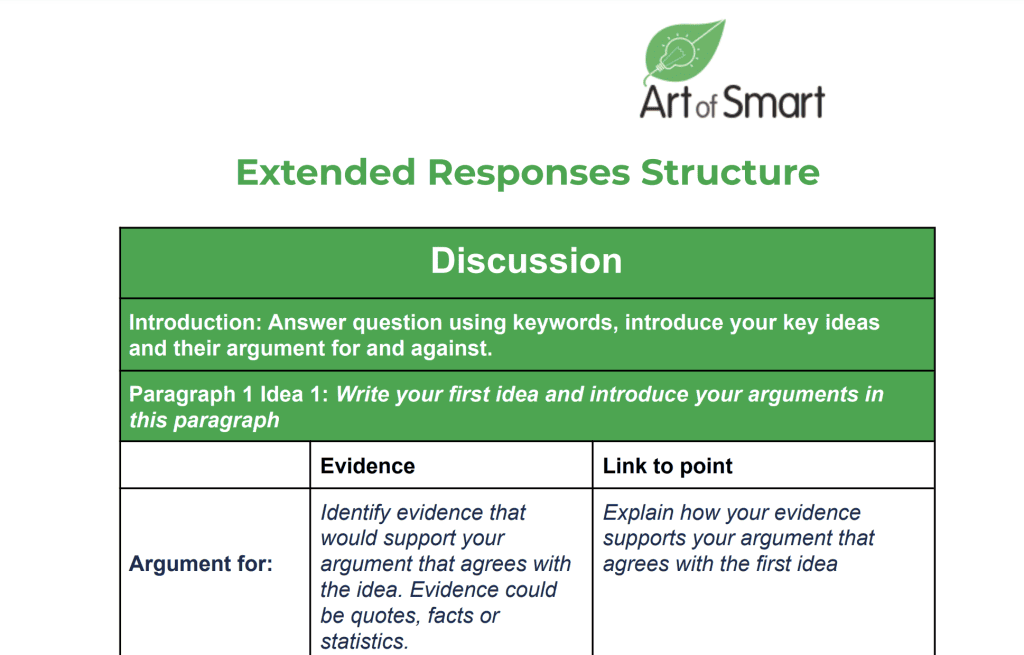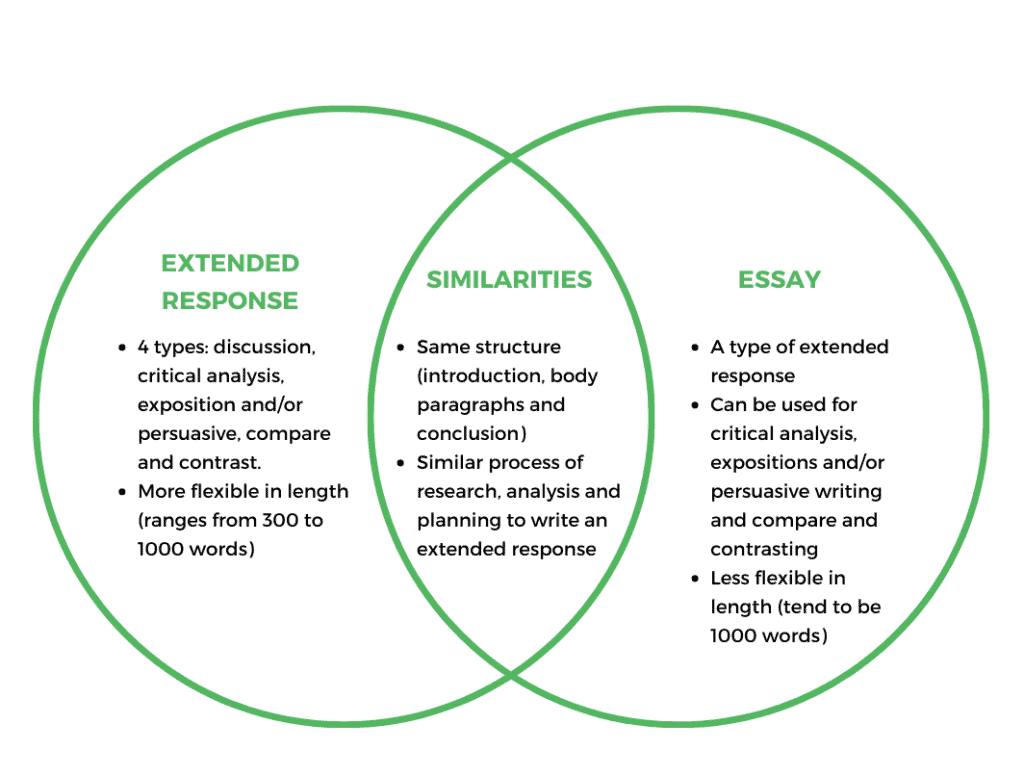It’s your first day in high school and your teacher has given you an extended response to write. But what is an extended response anyway?
We’re here for you! In this article, we will help you understand what an extended response is and how to write an amazing one to ace your assessments!
Plus, we’ve added in a downloadable scaffold sheet for you!
So, let’s dive right in!
What is an Extended Response in High School?
Types of Extended Responses for High School
How Long is a High School Extended Response?
How to Start Your Extended Response
How to Structure an Extended Response in High School
Extended Responses VS Essay: What’s the Difference?
What is an Extended Response in High School?
In short, an extended response is any piece of writing that is longer than one paragraph.
Research, analysis and planning are important when writing an extended response. However, answering the question is key to excelling your extended response.
To answer the question, avoid jotting down everything you know about the topic. Instead, focus on the ‘key words’ in the questions.
Tip: A good way to remember your ‘keywords’ is to circle or highlight them before you start planning your extended response.
An example of a key word would be an ‘action word’, such as ‘describe, ‘explain’ and ‘evaluate’. This will give you an idea of how you should be answering the question.
If the words ‘extended response’ sound scary, don’t worry! In Year 5 or 6, you’ve already started to write longer answers to challenging questions.
In high school, you’ll work further on these same skills, so you’ll step up to the next level!
Types of Extended Responses for High School
In most subjects, your high school teacher can ask you to write an extended response. This means that the type and structure of extended response can be different depending on the subject!
The good news is, your teacher can help you plan your subject-specific extended responses by providing detailed, up-to-date instructions.
This way, you understand exactly what you need to do! To give you an idea of what types of extended responses that you may be asked to write, here is a list:
Discussion
For discussions, you will explore two sides of the argument, otherwise known as “for” and “against”.
To contrast these arguments, you will learn how to use words such as “however”, “nonetheless” and “in contrast”.
Critical Analysis
For a critical analysis, you will need to show that you understand the text inside and out.
Oftentimes, this type of extended response is longer than the others. This is because you will need to write more than one paragraph per point.
Exposition or Persuasive
For expositions and/or persuasive pieces, you will need to make a strong argument to persuade your reader to side with you.
Compare and Contrast
For this type of extended response, you will need to write about the similarities and differences between two texts.
It is important that you show how the two text are similar and different, rather than story-telling the text.
Check out our breakdown and guide to using persuasive techniques here!
How Long is a High School Extended Response?
So, how long should an extended response be? 100, 200 or 500 words?
According to NESA, an extended response for high school should have an intro, at least 3 body paragraphs and a conclusion.
This means that your extended response will have at least 5 paragraphs in total with 3 to 7 sentences per paragraph, adding up to 300 to 500 words!
However, you can choose to write an additional body paragraph or two if you have more points to make to answer your question more effectively!
How to Start Your Extended Response
Most students make the mistake of jumping right into writing without thinking about what they want to write.
Instead, it is important to start an extended response by planning it out first!
You can start by asking yourself, “What is the question asking me to do?”.
A great tip is to circle or highlight the keywords in the question and define them. This helps to make sure you understand the question and in doing so, you’re able to decide on a key idea to answer the question directly.
Next, you would want to create a list of ideas or facts that address the question. A mind map is a great way to put your ideas on paper and make sense of it!
After this, you should find examples from your text that answer the question. These examples can be events, facts or quotes from your text which you may use to support your points.
Tip: A good trick is to try writing these notes down in your own words, to avoid copying other people’s work.
Finally, plan the structure of your extended response! You can do this by arranging your points in a logical order so the ideas link well together.
How to Structure an Extended Response in High School
Not sure how to structure your extended response in high school?
It’s as simple as ABC! An extended response has the same basic structure as an essay — with an introduction, a body and a conclusion.
Here’s a breakdown on how an extended response should be structured:
Introduction
In the introduction, you will need to answer the question directly and introduce the points that you will make in your body paragraphs.
Body Paragraph
NESA recommends that you have at least 3 body paragraphs in your extended response.
At times, more complex ideas will need more than one paragraph and that is totally ok!
However, try to separate your points into their own paragraphs, rather than mixing them all up in one paragraph. This is to make sure that your points are loud and clear for your teacher to understand!
Conclusion
At the end of your high-school extended response, you will write a conclusion which summarises the main points you have talked about in your extended response.
It is important to not mention new points here!
And don’t forget to reference your resources at the end of each assignment!
Extended responses VS Essay: What’s the Difference?
Wait, isn’t an extended response and an essay the same thing?
Well, not really. An extended response and an essay share the same structure — with its introduction, body paragraphs and conclusions.
The process of writing an extended response is also similar to writing an essay, with its research, analysis and planning.
So, what makes them different?
Think of extended response as a category, and this category is separated into its 4 types (ie. discussion, critical analysis, exposition/persuasive and compare and contrast).
Meanwhile, essays are a type of extended response that encompasses critical analysis, persuasive writing and at times, compare and contrast.
Additionally, extended responses are also more flexible in terms of its length, as it may vary from 300 to 1000 words, depending on how many points and paragraphs you have to make.
On the other hand, essays tend to be 1000 words long.
Here’s a Venn diagram to help you wrap your head around the similarities and differences between extended responses and essays:
And, That’s It!
Don’t forget to subscribe to our newsletter so you can receive free scaffolds for all 4 types of extended responses: discussion, critical analysis, exposition/persuasive and compare and contrast!
On the hunt for other useful resources?
Have another writing assignment? Here are our other writing guides:
- The Ultimate Guide to Writing a Feature Article
- The Ultimate Guide to Using Persuasive Techniques for English
- The Ultimate Guide to Writing a Recount in Primary School
- How to Write an Extended Response in High School
- The Ultimate Guide to Writing a Persuasive Text
- The Essential List of High Modality Words for Persuasive Writing
Are you looking for some extra help with writing your extended responses for high school?
We have an incredible team of tutors and mentors!
We can help you master your extended response writing and ace your upcoming assessments with personalised lessons conducted one-on-one in your home or online! We also have knowledgeable tutors in Western Sydney who can support you.
We’ve supported over 8,000 students over the last 11 years, and on average our students score mark improvements of over 20%!
To find out more and get started with an inspirational tutor and mentor, get in touch today or give us a ring on 1300 267 888!
Kate Lynn Law graduated in 2017 with an all rounders HSC award and an ATAR of 97.65. Passionate about mentoring, she enjoys working with high school students to improve their academic, work and life skills in preparation for the HSC and what comes next. An avid blogger, Kate had administered a creative writing page for over 2000 people since 2013, writing to an international audience since her early teenage years.









